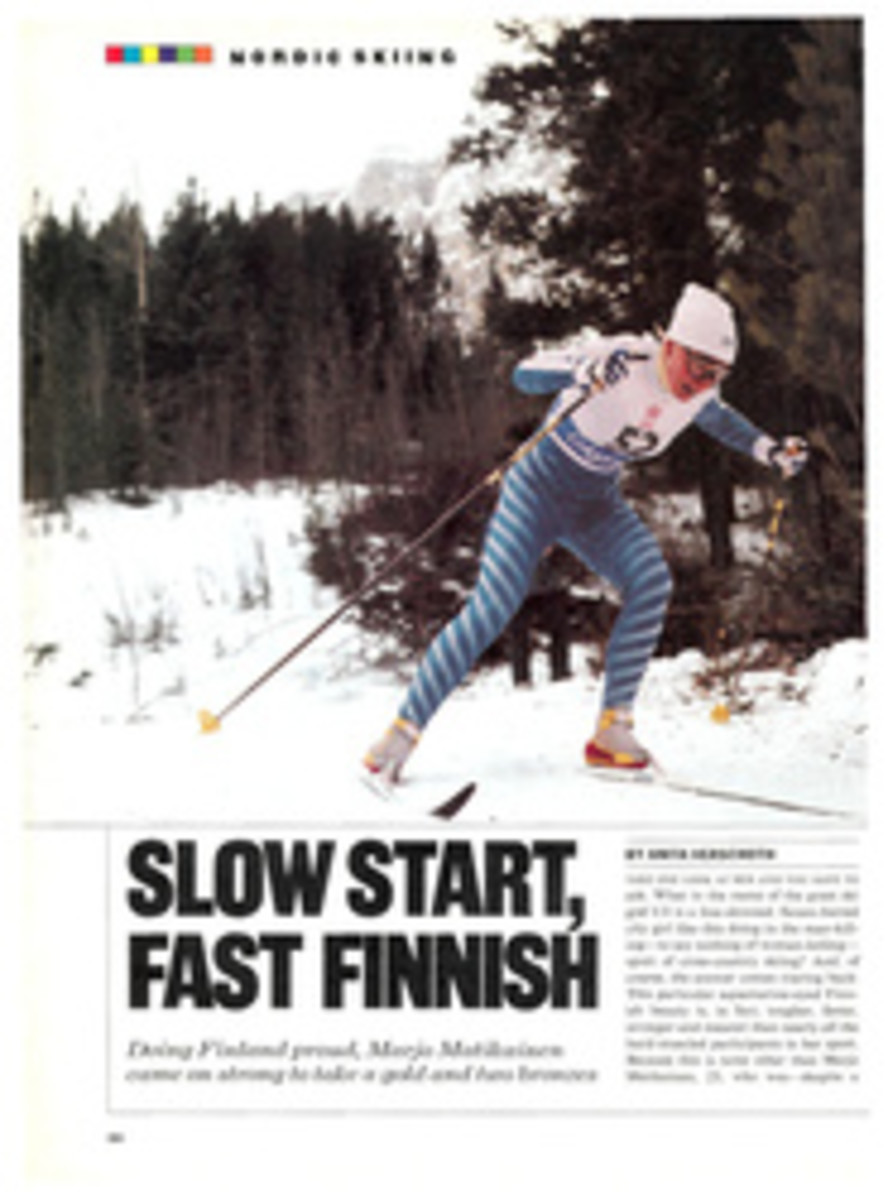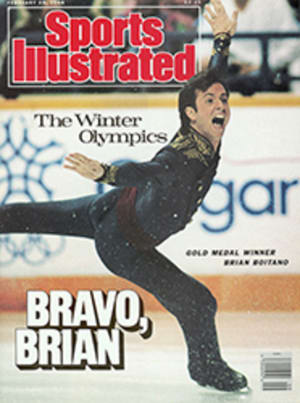
INFLEXIBLE FLIERS
Your can't put a winged keel on a luge, but U.S. Luge Association officials figured they had the next best thing. They brought a roll of special tape to Calgary. "It's the same stuff they use on airplanes," said Frank Marentic, the engineer who developed the tape at 3M. "We conducted wind-tunnel tests with it on a luge, and there were small but measurable reductions in drag." So on the eve of competition, USLA officials covered the bottom of each of the six U.S. singles luges with a strip of the 18-inch-wide tape, then slipped the sleds into bags marked U.S. LUGE TEAM—RESTRICTED—DO NOT REMOVE. "We wanted other countries to wonder what we had," said John Fee, the USLA's director of sports programs.
Maybe the U.S. did have something, because Bonny Warner placed sixth in the women's singles, the top individual Olympic finish in the sport by an American, and Frank Masley matched Jeff Tucker's 12th-place finish of 1980, the highest ever in the Games for a U.S. man. But the U.S. sliders could have put tape an inch thick on their sleds and spread Valvoline on the runners, and they still wouldn't have overtaken East Germany. The East Germans finished 1-4-5 in the men's singles, 1-2 in the men's doubles and 1-2-3 in the women's singles (there is no women's doubles). East Germany has won a whopping 34 of the 63 Olympic medals awarded in luge since the sport was added to the Games at Innsbruck in 1964. Through Sunday, that haul represents quite a share of the 103 medals overall the country has won since it began competing in the Winter Games in 1956.
Jens Müller started things off with a whoosh for the East Germans, setting a record of 46.301 for the 4,104-foot men's singles course on the first of his four runs. As if to tweak the U.S. for its technological gambit with the tape, Müller tested the very latest East German luge in practice, then tossed it aside and rode his trusty old Germina to victory.
Germinas are to East German kids what Flexible Flyers are to American youngsters. The Germina factory in Schmalkalden turns out hundreds of sleds each year but barely meets the demand of the luge-crazy populace. Thousands of tots spend their winter afternoons sliding on scores of small tracks throughout the country. As the youngsters progress, the best are selected for national training programs, and the very best train at East Germany's two world-class tracks, at Altenberg and Oberhof. "Their sliders have constant support and coaching from Day One," said Svein Romstad, coach of the 1984 U.S. Olympic team, who was in Calgary as an adviser for ABC television. "And they train fiercely year-round. School and work are sacrificed for luge. I don't care what kind of political system they come from, I have the utmost admiration for them."
Mere admiration? The East German women inspire awe. At the Sarajevo Olympics, Steffi Martin won gold, Bettina Schmidt won silver, and Ute Weiss won bronze. Last week only the names were changed, and not by much. Steffi Walter (nèe Martin) took the gold, Ute Oberhoffner (nèe Weiss) took silver, and a new Schmidt—Cerstin—won the bronze.
Walter is a wonder. A former shot-putter, she came late to luge—at 13—when her physical education teacher suggested she try it. She took last season off to have a baby. Perhaps now, hoped her opponents, she will stay at home, raise her child and dedicate herself to her beloved gourmet cooking. But Walter returned to training. "It wasn't easy to make the necessary commitment to get back into condition," she says. "It was an inner struggle."
Walter's husband cared for their son while she got herself back into shape. When the East German Olympic squad was first chosen, Walter's times were only the fourth-fastest, and there were but three places on the team. "But they gave me a few extra weeks," Walter says. "By then my times were better. I believe they gave me the chance because of what I did in '84." And only 14 months after the birth of Sebastian, she did it again. "Winning my second is a sweet feeling—I am on top of the world," she says.
An East German women's sweep was not unexpected. In five training runs the three switched places with one another, but allowed no interloper to crack third. The same thing happened in the four competition runs. "It's funny, watching them at the start," said U.S. slider Erica Terwillegar. "They know they're having their own little race. They watch each other but don't pay much attention to the other racers. We're all part of a different tournament, a contest for fourth place."
That last contest was won by Veronika Bilgeri of West Germany, but the U.S. women were in the thick of it. The best previous Olympic showing in the luge by an American woman was Kathleen Roberts's 14th-place finish in 1968, but in Calgary all three U.S. entrants did better than that. Warner, 25, a Stanford grad from Mount Baldy, Calif. led the way, and she was under considerable pressure to do so; by constantly boosting the sport in the U.S. and by steadily improving her own performances, Warner had thrust herself into the harsh Olympic spotlight. "But I don't mind any added pressure because I just don't get very nervous," Warner insists. "Some of the others do, but I don't."
Nerves she can control; the elements she cannot. In her second run on the 3,543-foot women's course, she was riding to a fast time when a gust of wind pushed her into a wall just before the finish. In eighth place after that run, she fought back to sixth largely on the strength of a strong fourth run.
"I've never been more relaxed before a run than I was before this one." said an ebullient Warner. "I knew I was going to go for it. Four years ago I really went for it at the end, and I crashed and wound up 15th. I'm a much better slider now, and I knew that if I went for it again, I could handle it. I made a bet with our coach, Wolfie Schaedler, right at the start house, that I could do it. I smoked it. I nailed it."
Cammy Myler, 19, and Terwillegar, 24, both first-time Olympians from Lake Placid, N.Y., finished ninth and 11th, respectively. Myler turned in four solid runs, but made several small rookie mistakes. Terwillegar, an alternate on both the 1980 and '84 Olympic teams, made the one big blunder that can befall an athlete who has waited a long time for a golden moment. After awaking on race day with a bad case of jitters, she charted a careful course in her first run. In the second, she responded to the wind by oversteering in Turn 8. She Ping-Ponged down the straightaway, smacking the wall three times. Her Olympic dream was turning nightmarish. But she straightened the sled and gained time on the bottom of the course. She calmed down after that harrowing run, turning in two fast times.
"Everyone's asking how bad that second run was," she said. "Actually, I thought it was a pretty good save. I was in big trouble there."
Terwillegar's tumultuous run pretty well reflects the status of American luge. It used to be that U.S. sliders followed trouble with more trouble, but now they know their way down a luge run, even while the perfect trip remains elusive. "The Americans are better than they used to be, no doubt about it," said Walter graciously. "They can go fast for a run, but they lack consistency."
For sure, the Americans no longer seem satisfied with being also-rans. Myler had this reaction to her Top 10 finish: "No, I'm not really happy with it. I wanted to do better. I could have done better." And Warner said, "In '92, I want to be a favorite for a medal. No more of this dark-horse stuff."
PHOTO
MANNY MILLAN
Using a trusty old sled, Müller sped to a course record on one run, then pressed on to victory.
PHOTO
HEINZ KLUETMEIER
For Walter and the rest of the East German women, it was as easy as one, two, three.
PHOTO
MANNY MILLAN
Warner's lofty sixth-place finish gave promise of bonnier days to come for U.S. competitors.
ILLUSTRATION

